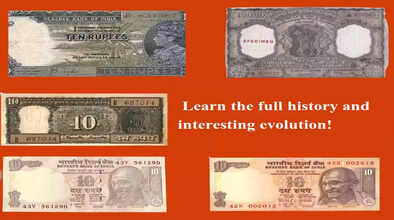10 Rupee Note: How many times has the appearance of this pocket-friendly note changed? Learn the full history and interesting evolution!

The 10 Rupee note is a crucial part of Indian currency. It was redesigned 8-10 times since independence. Gandhiji's image, the Konark Sun Temple, security features, and colors have evolved over time, so learn about its full history and design changes.
The 10 Rupee note is a crucial part of Indian currency, used for daily purchases. But do you know how many times it has changed? Before and after independence, this note underwent numerous changes, reflecting the country's culture, security, and technology over time. The Reserve Bank of India (RBI) has issued this note since 1938, and there have been approximately 8-10 design changes. So, let's explore the history of the 10 Rupee note, how the design was changed, and why these changes were necessary.
History of the 10 Rupee Note
Indian currency has a long history. While the 10 rupee note was issued during the British era, the RBI introduced a new series after independence. The RBI first printed the first 10 rupee note in 1938, but discontinued it in 1946 to prevent black marketing. It resumed circulation in 1954 and continued until 1978. In total, there have been about eight major design changes since independence.
Series of Design Changes
1. Lion Capital Series (1954-1967)
- This was the first series of independent India. The note featured the Ashoka Pillar (Lion Capital).
- Two peacocks were on the reverse. Languages were Hindi, English, and regional.
- Changes: simplified design, fewer security features.
2. Mahatma Gandhi Series (1969-1996)
- A new series commemorating Mahatma Gandhi's birth centenary in 1969, with Gandhiji's photo on the note.
- Three designs issued in 1970, 1975, and 1988, with the RBI and Ashoka Pillar watermarks.
- Language panel on the reverse, continued until 1996.
3. Mahatma Gandhi (New) Series (1996-2018)
- New series in 1996, with improved security features.
- Rupee symbol (₹) added in 2011, for the first time on the 10 rupee note.
- Image of the Konark Sun Temple on the reverse.
4. Mahatma Gandhi New Series (2018-present)
- New design in 2018, chocolate brown color, 123 mm × 63 mm size.
- Security features: See-through register (10 numbers), 10 in Devanagari, integrated image
- Konark Sun Temple on the reverse.
These four famous series claim to have undergone changes, but they have undergone sub-design changes, such as in 1970, 1975, and 1988. A total of 8-10 redesigns.
Why are design changes made?
Security: New features to prevent counterfeiting, such as watermarks and security threads.
Culture: Indian heritage on the reverse, such as the Sun Temple.
Technology: Adding the rupee symbol (2011).
Economic need: New prints as demand increases.
The RBI says that note designs are updated periodically.
Currently, the 10-rupee note
Color: Chocolate brown.
Size: 123 × 63 mm.
Front: Portrait of Gandhiji, RBI Governor's signature.
Back: Konark Sun Temple, 10 rupees in 17 languages.
Security: Watermark (Gandhiji), security thread.
Precautions
Keep notes clean and always stay updated with RBI guidelines to avoid counterfeiting.
It should be noted that the design of the 10 rupee note has been changed 8-10 times since independence. From the Lion Capital to the Mahatma Gandhi New Series, these changes were for security and culture. (Input: RBI)
5 FAQs
1. When was the 10 rupee note first issued?
– The 10 rupee note was first issued by the Reserve Bank of India in 1938.
2. How many series of the 10 rupee note have there been?
– There have been four main series so far: Lion Capital, Gandhiji Series, Gandhiji (New), and Gandhiji New Series.
3. Why are note designs changed?
– Designs are changed to prevent counterfeiting, add security features, reflect culture, and improve technology.
4. What is special about the 2018 note?
– Chocolate brown color, 123x63 mm size, Gandhiji's portrait, and the Konark Sun Temple on the reverse.
5. What are the security features of the 10 rupee note?
- Watermark (Gandhiji), security thread, see-through register, and integrated image.

